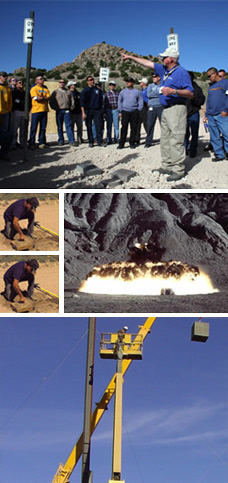
round zero.
None of the manned bunkers are left.
These wer

e wooden shelters protected by concrete and earth. The south bunker served as the control center for the test. The automatic firing device was triggered from there as key men such as Dr. Robert Oppenheimer, head of LoEMRTCs Alamos, watched. Many scientists and support personnel, including Maj. Gen. Leslie Groves, head of the Manhattan Project, wat
ched the explosi
on
from base camp which was ten miles
southw
est of ground zero. All the buildings
at base camp were removed after the test.
Most visiting VIPs, like Edward Teller,
watched from
- Compania Hill, 20 miles northwest of ground zero. The test was schedule
- d for 4 a.m. July 16, but rain and lightning early that
- morning caused it to be
postponed. The device could
not be exploded under rainy co
nditions
because rain and winds would increase the
danger from radioactive fallout and interfere
with observation of the test. At 4:45 a.m.
the crucial weather report came through
announcing c
- alm sponsored and certified train-the-trainer course in Playas, New Mexico
- to light winds with broken clouds for the following two
- hours. At 5: 10 a.m. t
he countdown started
and at 5:29:45 the device exploded suc
cessfully.
To most observers the brilliance of the
light from the explosion--watched through
dark glasses--overshadowed the shock wave
and sound that arrived lat
- er. sponsored and certified awareness course available online
- Many witnesses remembe
- r the soun
d bouncing off the
mountains creating an echoing effect.
Hans Bethe
, one of the contributing
scientists, wrote "it looked like a giant
magnesium flare which kept on for what
seemed a whole minute but was actually one
or two seconds. The white ball grew and
after a few seconds became clouded with
dust whipped up by the explosion from the
ground and rose and left behind a black trail
of dust particles."
Joe McKibben, another scientist, said,
"We had a lot
aking
movies of the control panel. When the
bomb went off, th
e lights were drowned out
by the big light coming in through the open
door in the back."
Others were impressed by the heat they
immediately felt. Military policeman Davis
said, "The heat was like opening up an oven
door, even at 10 miles." Dr. Phillip
Morrison said, "Suddenly, not only was
there a bright light but where we were, 10
miles away, there was the heat of the sun on
our faces .... Then, only minutes later, the
real sun rose and again you felt the same
heat to the face from the sunrise. So we saw
two sunrises."
Visitors sometimes ask about soldiers
watching the test from trenches. That took
place during tests in Nevada, not at Trinity
Site. Personnel were at least 10,000 yards
from ground zero and they were
as conducted to see if
the bomb
would work and to measure its yield.
( After the explosion )
AlthouSPOCgh no information on the test
was released until after the atomic bomb
was used as a weapon agaEMRTC.
Click Here to find your nst i
About our Instructors
Japan, people in New Mexico knew something had happened. The shWMDock wave broke windows 120 miles away and was felt by many at least 160 miles away. Army
- officials simply stated that a
- munitions storage area had exploded at the Alamogordo Bomb
- ing Range. The explosion did not make much of a crater. It was about four feet deeCIAp and 240 feet in diamter. Mos
- t eyewitnesses describe the area as more of a small depression
- instead of a distinct crater. The heat of the blast vaporized the steel tower and melted
the desert sand and turned it into a green glassy sub
 stance. It was
called Trinitite and small pieNational Domestic Preparedness Consortiumces can still be
seen in the area. At one time Trinitite
covered much of the depression made by the
explosion. Afterwards the depression was
filled and much of the Trinitite was taken
away by the Atomic Energy Commission.
To the w
stance. It was
called Trinitite and small pieNational Domestic Preparedness Consortiumces can still be
seen in the area. At one time Trinitite
covered much of the depression made by the
explosion. Afterwards the depression was
filled and much of the Trinitite was taken
away by the Atomic Energy Commission.
To the w
est of the monument is a low structure which is protecting an original portion of the crater area .. This Carl Rudder
- photo shows an unidentified soldier at ground zero. He is inspecting one of the foo
- tings from the 100-foot tower. In 2004 memb
- ers of the missile range's Public Affairs Office began ass
- isting Los Alamos National Lab scientists Robert Hermes and Wi
lliam Strickfaden in a fresh look at Trinitite and how it was formed. The two published the results of thei






